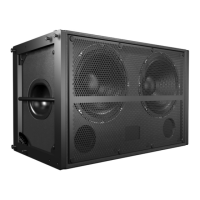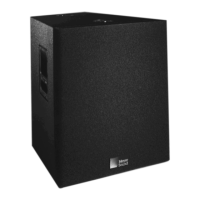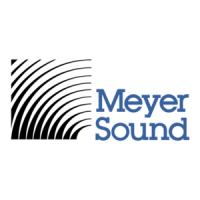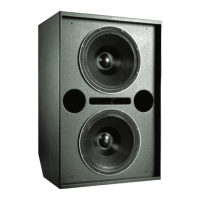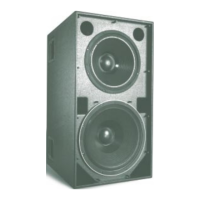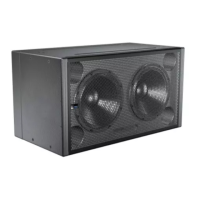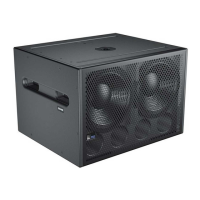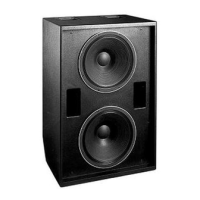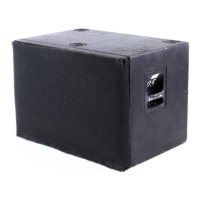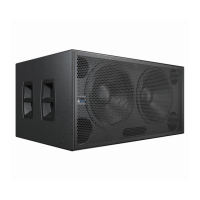M1D Rigging Grids and Accessories
PN: 05.115.001.01 B
Page 4 of 24
Meyer Sound Laboratories Inc.
www.meyersound.com
T: +1 510 486.1166
F: +1 510 486.8356
M1D Rigging Grids and Accessories
PN: 05.115.001.01 B
Page 5 of 24
Meyer Sound Laboratories Inc.
www.meyersound.com
T: +1 510 486.1166
F: +1 510 486.8356
SAFETY RESPONSIBILITIES “ABOVE THE HOOK”
In most touring applications of rigging systems, the touring sound provider is normally responsible for ensuring the
safety of the suspension system only below the attachment point. The safety and suitability of the attachment point is
generally seen as the responsibility of the venue owner or operator. However, this distinction (“above the hook” versus
“below the hook”) can be open to interpretation. Touring system operators should double-check to make certain that
attachment points are approved and suitably load rated, and that the points used are those identied as such by the
venue owner or operator. AS AN EXTRA PRECAUTION, CAREFUL INSPECTION OF THE ATTACHMENT POINTS
IS ADVISED BEFORE FLYING, PARTICULARLY IN OLDER VENUES OR THOSE HOSTING FREQUENT EVENTS
USING LARGE SOUND AND LIGHTING SYSTEMS. In any case, Meyer Sound QuickFly systems are intended only
for suspension from approved rigging points, each known to have ample SWL margins for the system components
suspended below them.
INSPECTION AND MAINTENANCE
The Meyer Sound QuickFly systems are an assembly of mechanical devices, and are therefore subject to wear and
tear over prolonged use, as well as damage from corrosive agents, extreme impact, or inappropriate use.
BECAUSE OF THE SAFETY ISSUES INVOLVED, USERS MUST ADOPT AND ADHERE TO A SCHEDULE OF
REGULAR INSPECTION AND MAINTENANCE. IN TOURING APPLICATIONS, KEY COMPONENTS MUST BE
INSPECTED BEFORE EACH USE. Such inspection includes examination of all load-bearing components for any
sign of undue wear, twisting, buckling, cracking, rusting, or other corrosion. In regard to rust and corrosion, the main
components of a QuickFly system are either protected by an exterior coating or made from stainless steel, which is
impervious to rust and resistant to most corrosive uids. Nevertheless, normal use and shipping vibrations can wear
through the protective coatings, and extremely corrosive uids (such as battery acid) can cause severe damage with
prolonged exposure even to protected parts. Particular attention should be given to screws, bolts, and other fasteners
to make certain the ttings are tight and secure. Metal seams and welds should be examined for any sign of separation
or deformation. Meyer Sound strongly recommends that written documentation be maintained on each QuickFly
system, noting date of inspection, name of inspector, points of system checked, and any anomalies discovered.
Annual Comprehensive Examination and Test Program
In addition to routine checks on the road for touring systems, Meyer Sound also recommends a careful,
comprehensive system examination and testing “at home” in the warehouse or other appropriate location at regular
intervals. Such at home examinations and tests should occur at least once a year, and should include a careful
inspection of each component under ideal lighting conditions, and then a nal comprehensive check of the entire
system after it has been own.
If any anomalies or defects are discovered that could possibly affect the safety or integrity of the system, affected
parts or subsystems should be replaced in their entirety before that part of the system is own again.
REPLACEMENT PARTS
Any component found to be defective, or any safety-related component you even suspect might be defective, should
be replaced with the equivalent, approved part. Parts specic to a QuickFly system should be ordered directly from
Meyer Sound. No attempt should be made to substitute what appears to be equivalent or “mostly the same” generic
replacements. Some parts used in QuickFly systems are identical to those used in other rigging applications. To the
best of our knowledge, most of these suppliers are reputable and their products are reliable. However, Meyer Sound
has no way of assuring the quality of products made by these various suppliers. Therefore, Meyer Sound is not
responsible for problems caused by components that were not supplied by Meyer Sound.
TRAINING
QuickFly systems are relatively straightforward and easy to use. However, they should only be used by persons trained
in the use of loudspeaker rigging systems who have mastered key points of assembly, rigging and ying. Users should
read this manual in its entirety before attempting to deploy any QuickFly system. You may make additional copies of
this manual as necessary for in-house use; copies may not be made for any other purpose.
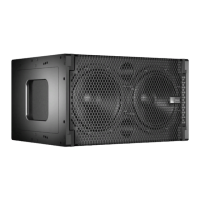
